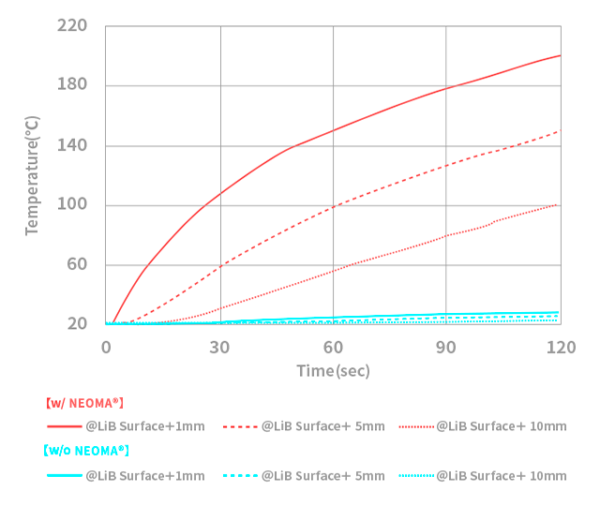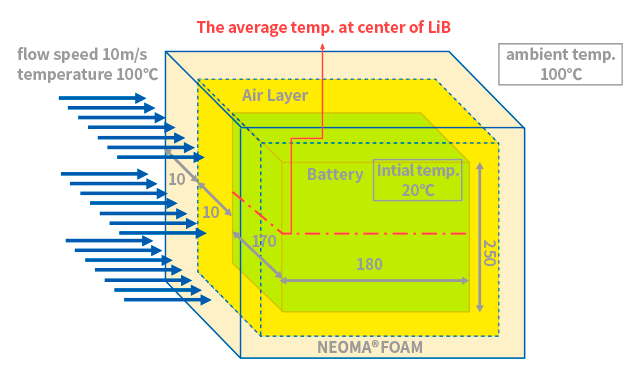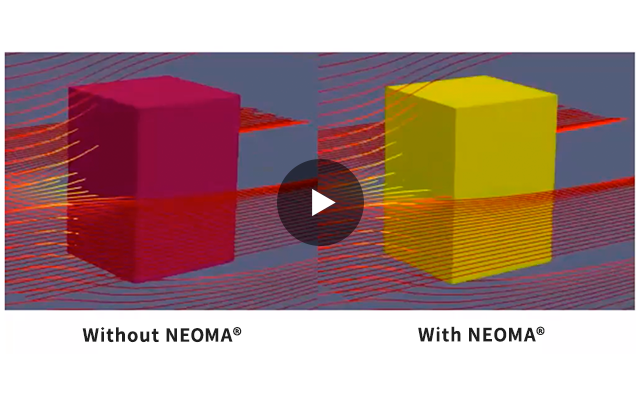Foam/Heat Insulation Material
NEOMA®FOAM
- Interior
- Under the hood
- Batteries


Marketing Areas
- JAPAN
NEOMA®FOAM is the foam with excellent heat insulation, flame resistance, as well as workability and achieves lightweight and high strength in a balanced manner. It contributes to weight reduction and higher functionality in various parts of automobiles.
Feature
- Heat insulation
- Light weight and strength
Usage
- LiB module cases
- Parts for which high heat insulation properties are required
In response to next-generation vehicle-related challenges of thermal management and fuel efficiency improvement derived from weight reduction, NEOMA®FOAM proposes a solution.
In response to next-generation vehicle-related challenges of thermal management and fuel efficiency improvement derived from weight reduction, NEOMA®FOAM proposes a solution.

High heat insulation
In the automotive industry, as technological innovations are advancing in a new area called "CASE," there is a growing movement to seek the comfort of houses inside vehicles as well.
The comfortable space of the highest quality created by NEOMA®FOAM with world-leading heat insulation performance is receiving attention in the automotive industry, let alone the housing industry.

Achieving both light weight and strength
NEOMA®FOAM uses its unique foaming technology to achieve light weight while maintaining strength that exceeds JIS standard values*. In addition, due to its high heat resistance, it exhibits excellent performance in terms of shape stability even in environments with large temperature changes.

Application for lithium-ion battery (LiB) module cases
To improve fuel or electricity consumption, further weight reduction is a must. An effective way to reduce weight is to change materials, especially changing of conventional materials to resin.
Replacing the materials of vehicle LiB module cases with resin is one such method. However, laws and regulations require a test in which the bottom of a vehicle LiB module case is heated by fire*. Therefore, replacing them with resin is difficult.
Accordingly, we focused on flame resistance for NEOMA®FOAM. We placed LiBs on NEOMA®FOAM in a module case, simulated and predicted the temperature increase, and checked if a fire would occur.
The results of the simulation revealed that NEOMA®FOAM prevents both the temperature of the LiBs from increasing and the module case from burning. Thus, NEOMA®FOAM is expected to contribute to the weight reduction of LiB module cases. Let’s compare NEOMA®FOAM with a commonly used steel sheet. The former is about 50 times lighter.
*The United Nations Economic Commission for Europe (UNECE) has set the following standard: The LiB module case must not burn in a gasoline pool fire test in which the module case is heated by a fire of 800°C for about 120 seconds.

Application to parts for which high heat insulation properties are required
The heat insulation of NEOMA®FOAM is represented by the world’s leading thermal conductivity, λ = 0.020 [W/(m・K)]. Compared with other heat insulation materials, NEOMA®FOAM provides reliable heat insulation performance with a thinner thickness. For example, it is said that the temperature of the roof of a car increases to nearly 80°C in direct sunlight in midsummer. Thanks to its heat insulation properties, NEOMA®FOAM whose thickness is only a few millimeters reduces the transfer of direct heat to the inside of the vehicle, thereby reducing heating and cooling energy.


Contribution to the environment
Heat insulation material that is surely friendly to the global environment
■CFC-free product ideal for the global environment
NEOMA®FOAM is developed as the industry’s first high-performance heat insulation material that does not contain any CFC or substitute for CFCs which was naturally used in the past. Now, the non-use of such substances has become a common practice.
■Efforts for recycling
Although it has been said that the recycling of phenolic resins, which are thermosetting resins, is difficult, Asahi Kasei recycles materials, utilizing its own technology.
■Product that complies with the Act on Promoting Green Purchasing
The Japanese government established the Act to require institutions including government agencies to preferentially select products or services that are less burdensome to the environment when they purchase such products or services. Heat insulation materials are subject to the Act. NEOMA®FOAM meets the criteria of the Act.
■Received the Minister of the Environment Award at the 18th Green Sustainable Chemistry (GSC) Awards in Japan.
The adjudicators evaluated that NEOMA®FOAM will contribute to resource saving, energy saving, as well as CO2 emissions reduction and help promote green sustainable chemistry thanks to the product’s excellent heat insulation properties and to its excellent properties which will not easily deteriorate for a long period of time.
■Measures for environmental regulations
We have inspected 10 hazardous substances including lead and mercury which are specified by the revised RoHS Directive (RoHS2) and which are contained in NEOMA®FOAM.
We have verified that the amount of each of the 10 substances contained in NEOMA®FOAM is below the standard value.
* RoHS is the safety standards, established by the European Union, for certain hazardous substances.
The standards are established to mainly restrict the use of the hazardous substances for electrical or electronic equipment. Although the former RoHS Directive regulated six hazardous substances, in the revised RoHS Directive, the number of such substances has been increased to 10.The materials of NEOMA®FOAM also comply with the Regulation concerning the Registration, Evaluation, Authorization and Restriction of Chemicals (REACH).
Contact us for further information on conditions such as compliance with the latest REACH-SVHC (substances of very high concern) List.
Product Q&A
QWhat is NEOMA®FOAM made of?
QIs phenol, the raw material of NEOMA®FOAM, classified as an environmental hormone?
QDoes NEOMA®FOAM burn?
QDoes NEOMA®FOAM absorb water?
QIs there any problem if NEOMA®FOAM is exposed to UV rays? Neoma FOAM was discolored after exposed to UV rays.
QDo the heat insulation properties of NEOMA®FOAM deteriorate?
QAre dust particles of NEOMA®FOAM harmful?
QHow do I dispose of leftovers of NEOMA®FOAM?
QCan I use NEOMA®FOAM in countries other than Japan?
 Mobility-related information website
Mobility-related information website



